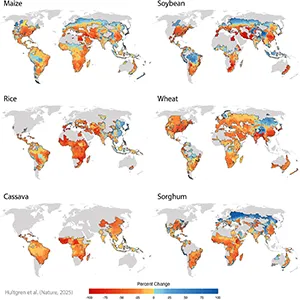Gaza’s hunger crisis has killed hundreds — including dozens of children from malnutrition – NBC News

Report on the Humanitarian Crisis in Gaza and its Conflict with Sustainable Development Goals
Executive Summary: A Severe Setback for SDG 2 (Zero Hunger)
Recent reports from the Gaza Strip indicate an alarming escalation of the hunger crisis, placing the region in direct opposition to the objectives of Sustainable Development Goal 2 (Zero Hunger). Health officials and humanitarian organizations on the ground have documented a sharp increase in malnutrition, particularly among children, with famine-like conditions now described as “striking Gaza alarmingly and terrifyingly.” The dire lack of adequate food has led to preventable deaths and widespread suffering, representing a catastrophic failure to ensure access to safe, nutritious, and sufficient food for all people.
Impact on Public Health: A Crisis for SDG 3 (Good Health and Well-being)
The nutritional crisis is precipitating a severe public health emergency, fundamentally undermining SDG 3 (Good Health and Well-being). Medical facilities, such as Al-Shifa Hospital, report being overwhelmed by patients suffering from malnutrition. The consequences are fatal, with a significant number of deaths directly attributed to starvation.
- The Palestinian Health Ministry reported 19 deaths due to malnutrition within a single 24-hour period.
- The World Health Organization (WHO) has recorded over 50 deaths of children from malnutrition since an aid-restricting blockade was initiated in early March.
- Dr. Mohammed Salmiya of Al-Shifa Hospital noted that over 70 malnutrition-related deaths have occurred since the conflict began.
These statistics illustrate a critical breakdown in the systems required to protect human life and ensure healthy living, a core tenet of SDG 3.
Humanitarian Aid Delivery: Challenges to SDG 16 (Peace, Justice and Strong Institutions)
The delivery of humanitarian aid is fraught with peril, highlighting a collapse of peace and security that contravenes SDG 16 (Peace, Justice and Strong Institutions). Civilians attempting to access life-saving food supplies face lethal risks. The mechanisms for aid distribution have proven both inadequate and dangerous.
- A recent incident resulted in over 90 reported fatalities among people trying to reach food aid convoys.
- The World Food Programme (WFP) reported that one of its convoys encountered large crowds that came under fire from Israeli forces, resulting in “the loss of countless lives.”
- The United Nations human rights office (OHCHR) stated that nearly 900 people have been killed in the enclave while trying to access food.
These events underscore the failure to protect non-combatants and guarantee safe access to humanitarian assistance, which is essential for justice and strong, effective institutions.
Analysis of Aid Efforts and SDG 17 (Partnerships for the Goals)
Despite various aid efforts, the scale of the response is critically insufficient, pointing to a failure in SDG 17 (Partnerships for the Goals). The collaboration required to address the crisis effectively is absent, and the volume of aid entering Gaza falls far short of the population’s needs.
- The Gaza Humanitarian Foundation (GHF) has distributed over 82 million meals since late May. For a population of 2.1 million, this equates to less than one meal per person per day.
- The World Food Programme (WFP) warns that nearly one in every three people in Gaza is “not eating for days at a time.”
- Prior to the conflict, approximately 500 aid trucks entered Gaza daily. While the Israel Defense Forces state over 700 trucks are currently inside the enclave awaiting distribution, aid workers describe the logistical environment as a “nightmare,” preventing effective delivery.
The gap between the aid provided and the immense need, compounded by logistical and security impediments, demonstrates a profound challenge to forming the effective partnerships required to achieve sustainable development objectives.
Analysis of Sustainable Development Goals in the Article
1. Which SDGs are addressed or connected to the issues highlighted in the article?
-
SDG 2: Zero Hunger
- The article’s central theme is the “hunger crisis in the Gaza Strip,” “famine,” and a “dire lack of adequate food.” It directly addresses the goal of ending hunger and ensuring access to food.
-
SDG 3: Good Health and Well-being
- The text highlights severe health consequences resulting from the food crisis, including a “growing number of children dying of malnutrition” and hospitals being “overwhelmed with waves of patients suffering from malnutrition.” This connects directly to ensuring healthy lives and well-being.
-
SDG 16: Peace, Justice and Strong Institutions
- The article describes violence and death affecting civilians, noting that “scores were killed waiting for supplies” and that crowds came “under fire from Israeli tanks, snipers and other gunfire.” This relates to the goal of reducing violence and promoting peaceful societies, as the lack of security directly impedes access to essential aid.
-
SDG 17: Partnerships for the Goals
- The article mentions multiple organizations involved in the aid efforts, including the World Health Organization (WHO), the World Food Programme (WFP), and the Gaza Humanitarian Foundation (GHF), as well as governments. It discusses the challenges and controversies surrounding these partnerships, such as the GHF being “criticized by the United Nations,” which is relevant to the effectiveness of global partnerships.
2. What specific targets under those SDGs can be identified based on the article’s content?
-
Target 2.1: End hunger and ensure access to safe, nutritious and sufficient food
- The article explicitly states that there is a “dire lack of adequate food” and that “Nearly 1 in every 3 people in Gaza is ‘not eating for days at a time’.” This directly points to the failure to achieve this target for the population of Gaza.
-
Target 2.2: End all forms of malnutrition
- The article provides direct evidence of this target not being met by reporting that “a growing number of children dying of malnutrition” and that hospitals are seeing “waves of patients suffering from malnutrition.”
-
Target 3.2: End preventable deaths of newborns and children under 5 years of age
- The report of “more than 50 children dying of malnutrition” since the blockade began is a clear example of preventable child deaths, which this target aims to eliminate.
-
Target 16.1: Significantly reduce all forms of violence and related death rates everywhere
- The article details multiple incidents of violence leading to death, such as “more than 90 people reported killed as they tried to reach food” and the UN report that “nearly 900 people had been killed in the enclave trying to access food.” This demonstrates a failure to protect civilians and reduce violence-related deaths.
3. Are there any indicators mentioned or implied in the article that can be used to measure progress towards the identified targets?
-
Indicator for Target 2.1 (Prevalence of severe food insecurity):
- The article provides a statistic from the WFP: “Nearly 1 in every 3 people in Gaza is ‘not eating for days at a time’.” This serves as a direct measure of severe food insecurity.
-
Indicator for Target 2.2 and 3.2 (Mortality rate attributed to malnutrition):
- The article provides specific numbers that can be used as indicators: “Nineteen deaths were recorded in Gaza due to malnutrition within the last 24 hours,” “more than 70 deaths related to malnutrition since the war began,” and “more than 50 children dying of malnutrition.” These figures directly measure mortality due to malnutrition.
-
Indicator for Target 16.1 (Number of civilian deaths in conflict):
- The article quantifies deaths related to aid distribution attempts: “more than 90 people reported killed as they tried to reach food” on a single day, and “nearly 900 people had been killed in the enclave trying to access food” according to the UN. These numbers are direct indicators of violence against civilians.
-
Indicator for Aid Effectiveness (related to SDG 17):
- The article provides data on aid delivery that can be used as an indicator of partnership effectiveness. It mentions that “Before the war, around 500 trucks carrying aid entered the enclave daily,” while current efforts by one organization equate to “less than one meal per person per day.” This comparison highlights a significant gap in aid delivery.
4. Summary Table of SDGs, Targets, and Indicators
| SDGs | Targets | Indicators |
|---|---|---|
| SDG 2: Zero Hunger |
2.1: End hunger and ensure access to safe, nutritious and sufficient food.
2.2: End all forms of malnutrition. |
– Prevalence of severe food insecurity: “Nearly 1 in every 3 people in Gaza is ‘not eating for days at a time’.” – Number of deaths from malnutrition: “Nineteen deaths were recorded in Gaza due to malnutrition within the last 24 hours.” |
| SDG 3: Good Health and Well-being | 3.2: End preventable deaths of newborns and children under 5 years of age. | – Child mortality from malnutrition: “more than 50 children dying of malnutrition.” |
| SDG 16: Peace, Justice and Strong Institutions | 16.1: Significantly reduce all forms of violence and related death rates everywhere. | – Number of civilian deaths related to accessing aid: “more than 90 people reported killed as they tried to reach food,” and “nearly 900 people had been killed in the enclave trying to access food.” |
| SDG 17: Partnerships for the Goals | 17.16: Enhance the global partnership for sustainable development. | – Volume of aid delivery vs. need: Comparison of current aid (“less than one meal per person per day”) to pre-war levels (“around 500 trucks carrying aid entered the enclave daily”). |
Source: nbcnews.com

What is Your Reaction?
 Like
0
Like
0
 Dislike
0
Dislike
0
 Love
0
Love
0
 Funny
0
Funny
0
 Angry
0
Angry
0
 Sad
0
Sad
0
 Wow
0
Wow
0












































































